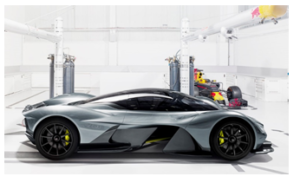Aston Martin’s $3M Hypercar Takes F1 Performance to the Road
Formula 1 cars sit at the extremes of engineering. They reach 60 mph in less than three seconds and, given the right track, approach 230 mph flat-out. Their engines sing at 18,000 RPM, more than twice the speed of most road car engines. Drivers experience at least four times the force of gravity in turns, an experience that would leave you struggling to hold your head up after a few laps. Driving an F1 car at speed demands exceptional reflexes and conditioning, which explains why even rookies are among the most conditioned athletes around.
All of which makes an F1 car nonsensical anywhere but a track. Yet automakers are keen to bring something approaching that level of performance to the street with seven-figure cars like the McLaren P1 and Ferrari LaFerrari.
Aston Martin joins that exclusive club with the AM-RB 001 developed with Red Bull Racing—the same outfit that dominated Formula 1 not long ago. Even among hypercars (supercar isn’t extreme enough for such things), it stands apart in its singleminded focus on performance. Renowned F1 designer Adrian Newey and Marek Reichman designed it to outperform every street-legal car on a track while being thoroughly “enjoyable” on the road.
“That’s the secret we’re trying to put into this car—the technology that allows it to be docile and comfortable, but with immense outright capabilities,” Newey said in a statement.
No one is saying much about the specs, but look for more than 1,000 horsepower from a naturally aspirated V12. Aston Martin promises a power to weight ratio of 1 horsepower to 1 kilogram, putting the weight at around 2,300 pounds. The company plans to build no more than 150 of them—at $2 to $3 million apiece—and another 25 strictly for the track.
Newey, the chief technical officer at Red Bull Racing, is an aerodynamicist, so you can count on the car producing phenomenal downforce for maximum grip. Nothing will be any larger or heavier than necessary.
Newey follows Gordon Murray, whose pioneering work includes the incomparable McLaren MP4/4, in making the jump from F1 to road cars. Murray designed the McLaren F1, which remains a performance benchmark—though he says his task was easier than Newey’s. “That was back in the late 80s, early 90s,” Murray says. “There was nothing else terribly clever around.”
The AM-RB is nothing if not clever. “I can look under the lovely body, because I know Marik and Adrian,” says Murray, “and underneath it’s just a racing car.” Remove that sleek bodywork, he says, you’ll probably find a teardrop-shaped racing tub with just enough room for two people and a drivetrain. “I keep reading that it’s going to be a usable everyday road car, and it patently isn’t,” he says. Knowing Newey, he says, there won’t be much space set aside for amenities. “I think they’re going to have massive issues in trying to pack stuff in,” he says.
The AM-RB 001 is long and low and curvaceous, its lines defined by those enormous ducts and scoops on the flanks. It’s even more distinctive from the front, where the air splitter resembles the front wing of an F1 car. The floor is elevated at the front, much like F1 cars not long ago, and the rear uses a diffuser to direct airflow.
That sculpting, along with aerodynamic sorcery underneath, will provide ample downforce to maximize cornering grip. Downforce increases with the square of speed, so “just enough” downforce at cornering velocities will become “scrape the belly on the ground” at high speed, Murray says.
Formula 1 cars work around this by having a board-stiff suspension in which the tires provide most of the cushioning. But they also race on smooth tracks, and drivers don’t expect comfort. That’s not the case with someone spending seven figures on a road car. Murray says the AM-RB 001 almost certainly will feature active suspension that can adapt on the fly to suit speed and road conditions—comfy for cruising, but all business on the track.
As to performance, no one’s offering any specific figures just yet, but Newey has said the track-only version will be as quick as a top-tier Le Mans endurance racer. To put that in perspective, Porsche’s Le Mans-winning racer lapped the historic Silverstone circuit at just a few ticks more than one minute and 40 seconds.
In some ways, the AM-RB 001 may be more advanced than the cars Newey’s designed for the likes for four-time champion Sebastian Vettel. F1 cars are governed by struct rules and regulations, which make true innovation difficult. Murray says he found designing road cars far more liberating, because he could do whatever he wanted. He appreciates the direction the AM-RB 001 team is taking, but it’s not a challenge that appeals to him.
“I love the look of the car, and I love the challenge, but if I had to do the F1 over again, it’s not the direction I would go,” he says. “I would stick entirely to the F1’s concept and usability, but bring it up to date with new technology.”
McLaren F1s now sell for north of $10 million, making the AM-RB 001 look like a relative bargain, so he may be on to something.
https://www.wired.com/2016/08/aston-martins-new-hypercar-clever-3m-beast/





